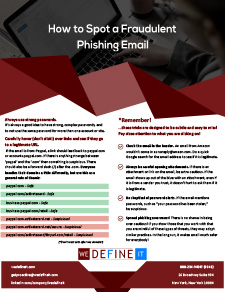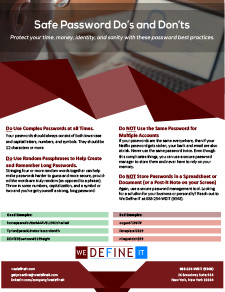If a Cybercriminal’s Gone Phishin’, Would Your Employees Take the Bait?
Use Phishing Simulation & Awareness Training to reduce your employees’ risk from phishing and other cyberattacks.
66% of cybercriminals rank email phishing as their attack vector of choice.
Phishing is a serious threat to businesses.
Phishing has become the #1 attack method of choice for cybercriminals due to its high success rate.
It’s simple enough to explain how to avoid email spam and other obvious attack vectors - but what if the attack looks like a message that they’d regularly expect from their contacts?
End users are the largest, most vulnerable target in most businesses. Your employees need to know how to spot a phishing attempt in order to avoid falling for one, and you need to know that they’re able to do so. We can help by phishing them for you.
How we can help.
According to the Ponemon Institute, organizations see a 64% improvement in phishing click rates with a security training program.
We’ll run quarterly phishing tests on your employees to help them practice spotting potential threats. Not only will they be informed of any mistakes they make, you will be told who among your organization needs additional education on the basics of phishing attacks.
Let us know if you’re ready to evaluate your employees.
Fill out the form on this page to let us know that you’re interested in implementing Phishing Simulation & Awareness Training to protect your company, your data and your employees.
Other research has supported this, finding that 90 percent of successful data hacks and breaches originate from phishing attacks.
However, there are a few ways that these attacks can be spotted, if one is paying attention. Your business can have a firewall and spam protection, but sometimes these threats slip through even the most high-end security tools. Your last line of defense is to educate your staff.

Get Started on Educating Your Staff
We want to help local businesses protect themselves from these targeted attacks, so we have a helpful guide for you to use. Reach out to We Define IT today to start a conversation on all of your options on how you can share these important best practices with your staff.
Get Your “How to Spot a Fraudulent Phishing Email” Guide
Fill out the form today to get your copy!
The Dark Web is No Place For Your Company’s Sensitive Data.
The Internet has Layers, One of Which Being the Dark Web.
When you visit the Internet, you are more than likely sticking to the pages that can be accessed by typing an address into your browser, or by clicking on a link in a search result. This is what is known as the surface web, and contains things like:
- Websites
- Reference materials
- Online stores
- Social media sites
- Search engines
- Blogs
You’ve probably also used something called the Deep Web, which is where all those pages that a search engine won’t bring up are kept. This includes online content that a search engine cannot access, but a user can with the right information, like:
- Online banking
- Email accounts
- Paid web services
- Medical records
- Restricted pages
- Internal networks
Even deeper than that is the Dark Web, an anonymous, hidden part of the Internet. Only accessible via specialized browsers, this impersonal expanse is far, far bigger than the Internet you are familiar with. Due to this, it has become a favorite place for criminals to exchange their ill-gotten goods in relative safety… especially data and information they have stolen from breached companies or services online.
Find Out if Your Data Has Been Stolen with a Complimentary Dark Web Scan!
Don’t assume that your business is “too small to be targeted”... cybercriminals know that they can be more successful targeting lots of small businesses than they can targeting one large one.
Where Does the Data on the Dark Web Come From?
As a cybercriminal infiltrates these businesses and services and gains access to their systems, they are able to steal many different kinds of valuable information (like user account credentials, credit card information, and many others) for them to sell to whomever they please. To buy and sell this information, these criminals turn to the anonymity of the Dark Web, which means that your data, your employees’ data, or your business’ data could be on the Dark Web for the taking.
Dark Web Monitoring Helps You Identify that You’ve Been Breached.
When it comes to cybercrime, knowledge is power. That’s why we combine our assets, human intelligence and artificial intelligence, into a unified effort to track down any instance of your data on the Dark Web with our scanning tools. If one of your users was caught in a breach, they can be identified and the issues mitigated from that point on. Through this service, you can be alerted if any of the information under your care is available on the Dark Web, allowing you to take steps to mitigate their use in further criminal endeavors.
Request Your Dark Web Scan Today!
Each minute you wait is another minute your data could be leaving you vulnerable. Complete the form for your free Dark Web scan, as well as a complimentary copy of our guide, “Safe Password Do’s and Don’ts,” right now.
When it comes to cyber threats, the “enemy” is continually looking for opportunities to exploit vulnerabilities, it makes it difficult, if not impossible, to protect everything, all the time.
43 percent of cyber attacks target small businesses.
To mitigate this ever-changing threat environment, it is important that you know where your risks really are and focus resources on continually eliminating the biggest threats.
You need to know that you:
- Have the proper tools in place to mitigate any risk of fraud or other crime?
- Are you able to fully protect your assets and resources, including your data, your website, your financial data, your intellectual property, and email?
- Can you currently meet your business sector's regulations and overcome its specific vulnerabilities?
If you are not able to answer these questions with a yes, then you are in need of a vulnerability assessment to learn how severe your risk is.
When it comes to your business's security it is important to stay proactive rather than reactive. And if your organization is required to comply with security standards like HIPAA, SOX, PCI DSS, a vulnerability assessment is more than a solid first step—it’s a necessary step mandated by these security standards.
You can’t protect your systems if you don’t know what risks you face.
A cybersecurity vulnerability assessment is essential for discovering your risks and defining appropriate mitigation strategies that fit your company’s specific needs.
What’s included in the Assessment Process?
The assessment process takes time to be completed as it depends on the size and the complexity of your network. The assessment process is broken down into several phases to achieve the goal of understanding your companies vulnerabilities to risk, identifying areas to improve upon, and to provide best practices to your security controls within your infrastructure.
- Identification
We will use our security scanning and other tools to identify external and external vulnerabilities.
- Analyze
We’ll look for holes in your security, detection, and prevention policies and practices that could lead to a breach.
- Report
We will provide and review with you a summary of all our findings and recommendations that you can use whether you work with us in the future or not.
Cybersecurity is not one and done.
Protecting your business is an ongoing process. With the ever-evolving threats, cybercriminals pose it is important to maintain a risk management program to continuously monitor your IT environment for new threats.
Find your vulnerabilities before the cybercriminals do!
Request an assessment and we’ll contact you!

